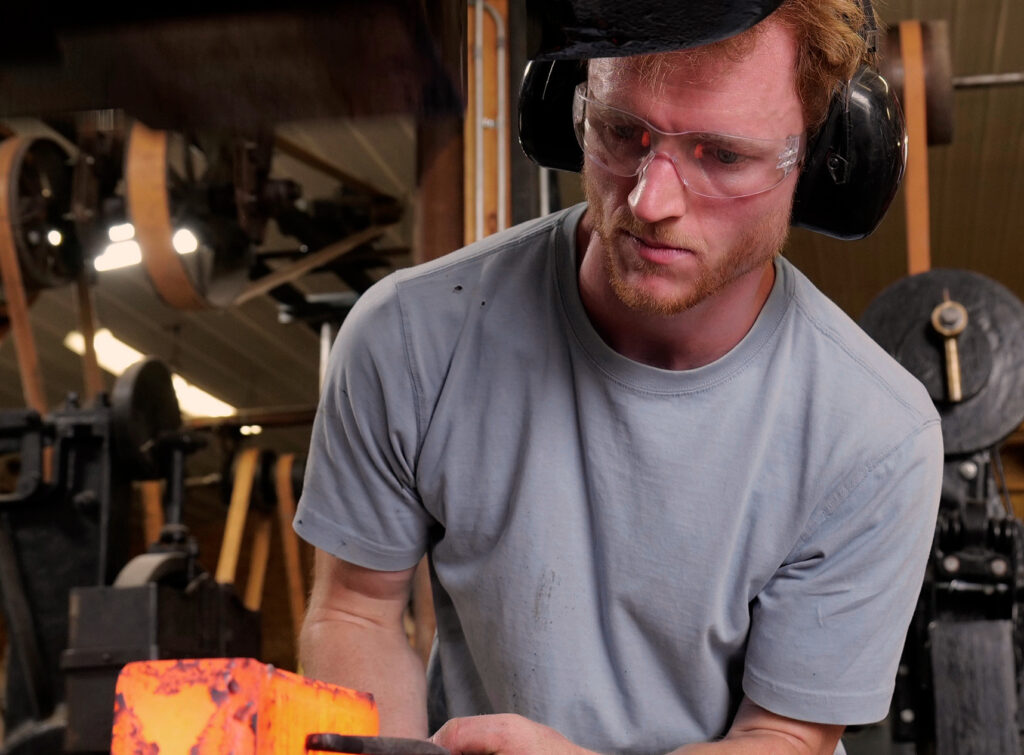
As sometimes happens, mid-summer I found myself in the middle of Averil Park, NY, sitting outside a yurt in front of a large, pallet-fueled fire pit with my good friends Chris and Josh. We were enjoying a little Japanese whiskey when someone I had not met before rolled up to the group. A quiet and contemplative man who when opened up, revealed a whole new world of artisan craft to me. Meet Jordan LaMothe, an artisan blade maker.
Please introduce yourself and tell us a little bit about your creative life and craft?
I am a blacksmith and knife-maker based in Hebron, NY, and I make all manner of blades from chef knives to swords. My work is a continual balancing of form and function; to make pieces that are both highly effective cutting tools and elegant, visually pleasing objects. When I make a knife, I start with raw bars of steel from the mill, forge weld different alloys to create an intricate pattern, and shape the blade with hammer and anvil. I then transform that forged blank into a cutting tool: hardening and tempering the steel, and grinding and sanding the blade to refine the shape and edge geometry. I then fit a handle to the blade, carefully selecting the material and sculpting it for the desired visual and ergonomic effect.
How did you get interested in knife making? What special education / skill did you need to acquire?
I began blacksmithing at the age of fourteen in order to make tools and hardware for use on the family farm. In two years, I made my first knife. I was captivated by the variety of creative processes involved: forging, grinding, machining, woodwork, leatherwork. So, I joined the American Bladesmith Society and dove into the craft, reading books and online forum posts, experimenting in my own shop. Then I started bringing my knives to accomplished bladesmiths for their critique.
I imagine you are doing custom work for a lot of folks in the food industry. Has the pandemic had an effect on your business?
I am fortunate that the pandemic has not affected my knife sales in any noticeable way. Many of my culinary knife clients are avid home chefs, and that market has done quite well with so many folks working from home. However, several of the classes I was scheduled to teach in 2020 and 2021 were cancelled due to the pandemic.
With the proliferation of mass production in your industry, how do you differentiate yourself?
People buy my work because it has a story, because they like the aesthetics of my work, and because they trust me to create tools that will perform well and last a long time. A mass-produced knife is a completely different product and a different marke. There are some terrific mass-produced knives, but generally people are looking for something “good enough” for their particular needs. When you purchase a knife from me, you receive a piece that is truly unique and personal—something no one else in the world has.
What are your long term goals with your craft? What would you like to accomplish?
My current goal in my craft is to broaden the variety of techniques that I can apply to my pieces. I am interested in doing more work with precious metals as well as inlay and engraving. I also want to do more research and documentation of historical swords and daggers in order to make pieces that remain faithful to the long traditions from which they descend.
Any thing you would like us to know about specifically? Any upcoming classes or exhibitions?
In 2022, I am going to be traveling to Rajasthan, India, on a Fulbright grant in order to study koftgari: a technique for applying gold and silver onto iron that has been used for hundreds of years to embellish sword and dagger hilts. I will resume teaching classes and attending shows once I return in 2023.
EDITORS NOTE: For more information or to contact Jordan directly about commission work or classes hit him up on these website or social media platforms:
Web: www.jordanlamothe.com
IG: @jordanlamotheblades
